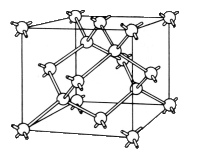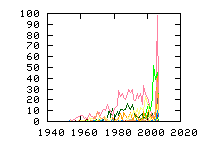« Previous
1
Next »
(7 hits, 1/1)
Showing
10, 25, 50, 100, 500, 1000, all papers per page.
Sort by:
last publication date,
older publication date,
last update date.
- 1. J. Appl. Phys. 104, 014106 (2008) , “Analysis of electrically biased paramagnetic defect centers in HfO2 and HfxSi1−xO2 / (100)Si interfaces”, P. T. Chen, B. B. Triplett, J. J. Chambers, L. Colombo, P. C. McIntyre, and Y. NishiThis study reports on the first experimental observations of electrically biased paramagnetic defects at 800 °C N2 annealed HfxSi1−xO2 (x=0.4, and 0.6)/(100)Si and HfO2/(100)Si interfaces in metal oxide silicon... (Read more)
- 2. Microelectron. Reliability 46, 1 (2006) , “NBTI degradation: From physical mechanisms to modelling”,An overview of the evolution of transistor parameters under negative bias temperature instability stress conditions commonly observed in p-MOSFETs in recent technologies is presented. The physical mechanisms of the degradation as well as the different defects involved have been discussed according to a systematic set of experiments with different stress conditions. According to our findings, a physical model is proposed which could be used to more accurately predict the transistor degradation. Finally, based on our new present understanding, a new characterization methodology is proposed, which would open the way to a more accurate determination of parameter shifts and thus allowing implementing the degradation into design rules. (Read more)
- 3. Microelectron. Reliability 45, 57 (2005) , “Characterization of interface defects related to negative-bias temperature instability SiON/Si<100> systems ”,Interface defects related to negative-bias temperature instability (NBTI) in an ultrathin plasma-nitrided SiON/ Si<100> system were characterized by using conductance–frequency measurements, electron-spin resonance measure- ments, and synchrotron radiation X-ray photoelectron spectroscopy. It was confirmed that NBTI is reduced by using D2-annealing instead of the usual H2-annealing. Interfacial Si dangling bonds (Pb1 and Pb0 centers) were detected in a sample subjected to negative-bias temperature stress (NBTS). Although we suggest that NBTS also generates non-Pb defects, it does not seem to generate nitrogen dangling bonds. These results show that NBTI of the plasma-nitrided SiON/Si system is predominantly due to Pb depassivation. Plasma nitridation was also found to increase the Pb1/Pb0 density ratio, modify the Pb1 defect structure, and increase the latent interface trap density by generating Si suboxides at the interface. These changes are likely to be the causes of NBTI in ultrathin plasma-nitrided SiON/Si systems. (Read more)
- 4. Appl. Phys. Lett. 82, 3677-3679 (2003) , “Interface defects responsible for negative-bias temperature instability in plasma-nitrided SiON/Si(100) systems”, Shinji Fujieda, Yoshinao Miura, and Motofumi SaitohInterface defects generated by negative-bias temperature stress (NBTS) in an ultrathin plasma- nitrided SiON/Si(100) system were characterized by using D2 annealing, conductance-frequency measurements, and electron-spin resonance measurements. D2 annealing was shown to lower... (Read more)
- 5. Appl. Phys. Lett. 82, 269 (2003) , “Relationship between interfacial nitrogen concentration and activation energies of fixed-charge trapping and interface state generation under bias-temperature stress condition”,The influence of nitrogen concentration at a nitrided oxide/silicon interface on the activation energies of both near-interface fixed-charge trapping and interface state generation caused by negative bias temperature instability stress has been studied quantitatively. It is observed that the charge... (Read more)
- 6. J. Appl. Phys. 94, 1 (2003) , “Negative bias temperature instability: Road to cross in deep submicron silicon semiconductor manufacturing”,We present an overview of negative bias temperature instability (NBTI) commonly observed in p-channel metal–oxide–semiconductor field-effect transistors when stressed with negative gate voltages at elevated temperatures. We discuss the results of such stress on device and circuit... (Read more)
- 7. Appl. Phys. Lett. 81, 2397-2399 (2002) , “Hydrogen redistribution induced by negative-bias-temperature stress in metal–oxide–silicon diodes”, Ziyuan LiuPoly-Si/SiO2/Si diodes in which oxides were grown thermally under wet oxidation conditions and subsequently treated by a post-oxidation anneal (POA) have been characterized electrically and chemically before and after applying negative-bias-temperature stress (NBTS). It was confirmed that... (Read more)
« Previous
1
Next »
(7 hits, 1/1)
Showing
10, 25, 50, 100, 500, 1000, all papers per page.
Sort by:
last publication date,
older publication date,
last update date.
All papers (3399)
Updated at 2010-07-20 16:50:39
Updated at 2010-07-20 16:50:39
(view as: tree
,
cloud
)
| 1329 | untagged |
Materials
(111 tags)
Others(101 tags)
Technique
(46 tags)
Details
(591 tags)
Bond(35 tags)
Defect(interstitial)(18 tags)
Defect(vacancy)(15 tags)
Defect-type(19 tags)
Element(65 tags)
Energy(8 tags)
Isotope(56 tags)
Label(303 tags)
Sample(17 tags)
Spin(8 tags)
Symmetry(15 tags)

